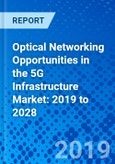Since the researcher published its first report on optical networking in the 5G infrastructure market in 2017, a lot has happened in the 5G world. In particular, expectations for subscriber numbers have grown, leading more bullish expectation for PON, WDM, Carrier Ethernet, space division multiplexing and optical cable in 5G-focused backhaul and fronthaul nets.
The report includes profiles of 17 mobile operators with advanced 5G strategies, showing how these carriers are planning to deploy optical networks and who their suppliers of hardware and cable will be. It also includes analyses of the leading optical equipment and optical cable suppliers for the 5G infrastructure. There are also detailed 10-year forecasts in volume (ports) and value ($ Millions) terms of both optical equipment and cable with breakouts by type of technology, fronthaul vs. backhaul deployment, and geography.
Who should read this report?
Whether you are an optical component manufacturer, optical equipment manufacturer, large end-user, or investor, you will gain valuable insights from this in-depth research.
Table of Contents
Executive Summary
Companies Mentioned
- AT&T
- Charter Communications, Inc.
- China Mobile
- China Telecom
- China Unicom
- Ciena
- CommScope
- Corning
- EE
- Ericsson
- Fujikura
- Huawei
- Infinera
- KDD
- KT Corporation
- LG Uplus
- Nexans
- Nokia
- O2
- OFS/Furukawa
- Orange
- Prysmian Group
- SK Telecom
- Softbank
- Sterlite Technologies
- Sumitomo Electric Lightwave
- T-Mobile/Sprint
- Three UK
- Verizon
- Vodafone
- Yangtze Optical Fiber (YOFC)
- ZTE








